Mike Mignola isn’t doing as much with Hellboy as he used to. But, with new collections of classic material and fresh storylines about the Right Hand of Doom and the BPRD coming out, he’s never too far from his signature creation.
Hellboy contemplates an unexpected turn of events. Image: Sebastian Fiumara, Dave Stewart (Dark Horse Comics)
Though the character bowed out of a starring role last year in a poignant goodbye, the fictional universe that grew around Hellboy continues in various comic-book series. New omnibus collections will be re-packaging the character’s appearances in chronological order, and a new Hellboy movie is in production too, due to hit screens early next year.
Mignola graciously spoke to us about the past, present and future of Anung Un Rama during a recent phone call.
Big changes are happening to the Hellboy universe. Some in the real world, some in fiction. Hellboy’s history has been kind of out-of-order. Readers learn about things in the distant past in the present day and occasionally get teases about the future. What prompted the decision to put these new Hellboy Omnibuses out in chronological publishing order?
Mike Mignola: Well, this is something that’s a pet project for [editor] Scott Allie. He’d been wanting to do this for years. So, the release of the movie was his excuse to finally do this major overhaul.
It was a big undertaking. There are so many short stories that the question becomes, do you try to do everything with the short stories and the big books in one? Do all that? In the proper chronological order?
But being a short story guy, I always loved the idea of the standalone short stories being separated out. To do those in chronological order, but then to do the big stuff in chronological order. Scott was there to sort that out.
The short stories that reference the big epic of Hellboy, those are inserted into the collections of the big story. But I’ve always thought that short stories were the best way to introduce somebody to Hellboy, and I travel with the Hellboy trade paperbacks with short stories so I can give to people.
They’re just fun, little teasers of what Hellboy does and you don’t need to know the big story.
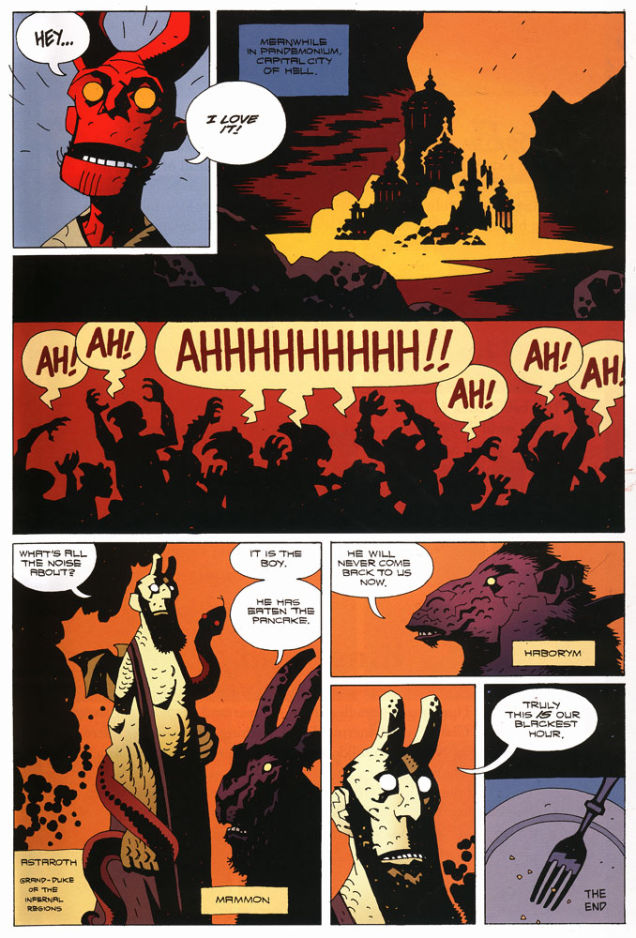
A page from my personal favourite Hellboy short story. Image: Mike Mignola (Dark Horse Comics)
To the point we get two fat volumes of those short stories, and we get the four volumes that are the big story. It really ended up working rather nicely.
Also, especially with the movie coming out, we really loved the idea of putting the three Duncan Fegredo books together in one omnibus since they make up one major arc of Hellboy.
So, yeah, it was a lot of work and I’m really glad I didn’t have to do much. But that was Scott Allie doing all the heavy lifting.
Speaking of Hellboy’s big overarching story, how much of his life did you plan out beforehand?
Mignola: I mean, at the very beginning, I didn’t really have much of an idea. Going back to the very beginning, the book was never really supposed to be about who Hellboy was. That origin sequence at the beginning of the very first book Seed of Destruction that was really meant to be it, as far as, “Oh, Hellboy just shows up”.
By the end of that miniseries, Rasputin had started laying out some kind of prophecy stuff, and in the second book, there was more of this prophecy stuff. Even as I was writing this prophecy apocalypse kinda stuff, I didn’t really know where the book was going.
In fact, I kept getting mad at myself for throwing this stuff in there, because the more characters that talked about his destiny, the more I went, “Shit, now I’m going to have to resolve that, at some point…” So I’m not really sure when the whole thing started to take shape, but the trick was to write it vague enough so I didn’t really write myself into a corner.
I knew something [big] was going to happen. Little by little, as these characters spouted these various things, I’d come up with a list of shit I had to deal with and figure out.
Having wrapped the whole thing up, a lot of it was making sure – and I’m sure there are some things that never got resolved – that, yeah, we did get this and that, we answered what this was, and I think I resolved what this means… But, no, when I started this thing, I didn’t know where it was going to go.
Do you feel like there are tonal changes that have happened as you’ve been writing this character for 25, 30 years?
Mignola: Oh, yeah! It definitely was more of an action/adventure book at first. One thing that’s very strange seeing, especially in this short story collection, is this stuff being arranged in a radically different order than it was drawn or written. I think those things will be odd because you get this radical art style change or tone change from one story to the next.
But Hellboy has always reflected where I was as far as my energy level and interests.
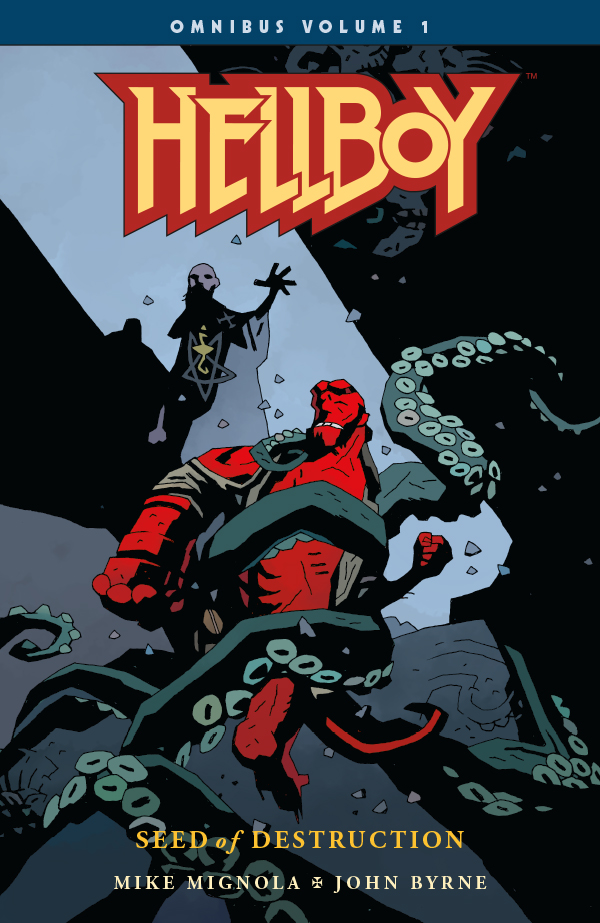
The cover for the first Hellboy Omnibus volume. Image: Mike Mignola (Dark Horse Comics)
There are certainly stretches that are more grim, and others that are more quiet early on. More or less, I was doing a mainstream adventure book so there was a lot more emphasis on action. The second Hellboy miniseries, Wake the Devil, has maybe my all-time favourite action sequence, because it was just something I’d never really done, and I was just excited to do it. And I’m really happy with it.
But having done it, I never felt the need to do that kind of thing again. So, you get much longer fight scenes in the early stories because I was still coming out of mainstream comics. But having done them, I didn’t really feel the need to do them again.
Once I’d done Conqueror Worm – which has a lot of moving parts and is a team book adventure thing – I felt like I did a pretty good job with that and never felt the need to do anything like it again.
Then you get to something like The Third Wish, which is the story I did right after 9/11. That story was meant to be a fun, little goofy mermaid story I made up a long, long time ago, turned into a Hellboy story. But that story turned out very dark and grim and quiet and sad because I was in New York right after 9/11… it couldn’t help but seep into the story. Not consciously. But, it’s just where my head was at.
So, I think that is the beauty of plotting these things very loosely and not having this really rigid plan. Some of these stories really do just catch whatever my mood is at the time.
Let’s talk about current work. Right now, The Devil You Know is coming out. You contributed interiors to that project. What was it like coming back?
Mignola: I only did the first three pages of the story where Hellboy comes back. When I plotted this, I didn’t say, “When we do bring Hellboy back, let me jump in and do this sequence where we move Hellboy from where I left him at the end of Hellboy in Hell and back to the BPRD.”
I ended Hellboy in Hell in such a strange place that I felt I needed to visually go back and address how we move Hellboy from one location to the other. And it was a weird sequence, as it was always meant to be.
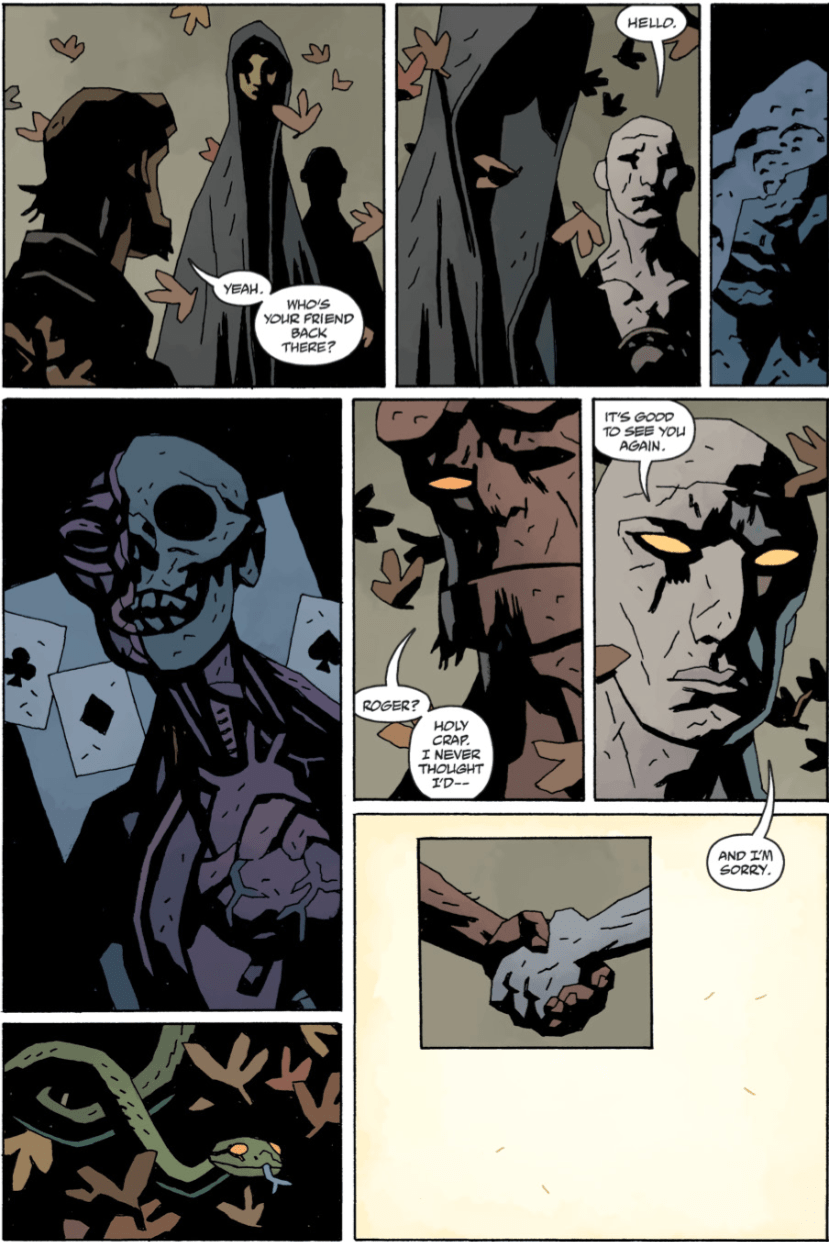
Roger the Homunculus and Hellboy reunite in the netherworld. Image: Mike Mignola (Dark Horse Comics)
Again, it’s not really spelled out or explained, but it needed to have that same visual language that I gave the end of Hellboy in Hell. It’s strange but I think when I finished Hellboy in Hell, I really did feel like I was done. Even if I knew I always had to go back and address some of this stuff later, I really felt finished.
It was a little bit like pulling teeth wrapping up that series. My brain says, “We feel like we’re done,” but what my heart heard was, “Oh, we’re done? We never have to draw this again? No, no… we’ve got to get back in that place where we can get excited about doing him again.”
Fortunately, after 25 years, I still enjoy drawing the character, so it wasn’t that hard to get back there. What you’ll see is I do Hellboy in smaller and smaller doses these days, because I really have mentally moved on to other things. But it will always be pleasant to do him. And it’s important to really, as we’re wrapping up BPRD, to do it right.
The other big teaser in current Hellboy work revolves around Roger the Homunculus.
Mignola: You know, Hellboy always had to come back. Hellboy always had things left to do. So, the idea was to use Roger as a vehicle to bring Hellboy back. Roger was, you know, one of our favourite characters. We killed him off early. And I think probably Scott came up with a reason for why they would have to go to Roger’s grave.
But the idea of Hellboy and Roger having to go to the Union in Hell, I had various ideas of how to do that, even when I was doing the Hellboy in Hell stuff. I had to have Hellboy run into Roger, because he never had a chance to say goodbye to Roger. The idea of them actually meeting up in the afterlife was actually kind of nice.
Roger basically has to serve as the doorway to get Hellboy back to Earth and he feels bad about it. “I come to your house where you’re nice and quiet and peaceful and I’m sorry, but I gotta deliver you back to a real shitstorm.”
The sequence ended up being very short. I could’ve gone on much longer with the Hellboy/Roger reunion, but as is the case with so many of these things, it was better to do it brief and sad and not overstay your welcome and talk it to death. You know, “Nice to see you. Yeah, I’m really sorry that I’m here for this reason.” Hopefully, that came across.
Where are you at with Witchfinder? He’s Hellboy-adjacent but an altogether different character that’s spun off into a new series.
Mignola: I love the character of Sir Edward Grey/Witchfinder. I introduced a bunch of ideas with that character and really set the stage for him. Like so [many] of these characters, I did the origin, explained the beginnings, and wrote his first full-length adventure. And then I also wrote the death of the character and how he ends up in Hell.
So, I always had a rough outline for what his life would have been, but I was always happy to give that outline over to Chris Roberson. He is such a fan of the same Victorian-era stuff that I am. I think Chris has said Ed Grey is his favourite of the Hellboy characters. So, we discussed in some detail an arc of the Witchfinder’s stuff.
But for the most part, other than discussing it back and forth, I’m really leaving it to Chris to flesh it out.
What have your conversations with [Hellboy and Stranger Things actor] David Harbour been like, in terms of defining Hellboy as a character?
Mignola: It was really interesting with David, because we met very briefly for 20 minutes when he was in town. Then he would text me periodically with questions, like, “Are there any animals you thought of in the way Hellboy moves?” And we were texting back and forth one night a lot about crazy stuff like that, and I finally said, “Dude, I am tired of typing, just call me.”
We must have had this two-hour conversation where we got into the way I grew up, what my brothers were like, and all this stuff that fed into what Hellboy is. The attitudes, the characters, and stuff like that… and hopefully it didn’t fuck things up, because it was way more information and backstory to the creative process than anyone would ever need. But it did make for an interesting, long phone call.
And I know David has his own ideas about how to interpret the character, but it was really nice that we had this one, really long conversation about where this stuff came from.
I know there’s probably not a whole lot you can talk about with the upcoming Hellboy movie, but what’s your take on it? How do you envision it among all this superhero stuff all over the place now?
Mignola: Well, I mean, if anything, we’re trying to do something very different. Basically, there’s no part of Hellboy that was ever going to be like other superhero movies.
And the more Marvel stuff there is, the more DC stuff there is, Hellboy never really feels like – even in the [Guillermo] del Toro things – a superhero movie. It’s so much “big teams of guys, in costumes, running around and saving the world from big cosmic menace stuff…”
I believe the new movie will feel even less like a regular superhero thing. The idea with this one was to make it play much less like a superhero film, to downplay the superhero elements even more than del Toro did. This one is much more folklore/mythology/horror, and not “big team rushing into to do battle with whatever kind of stuff”.
You just reminded me that you touched on the New Gods in a major way when you drew Cosmic Odyssey. What do you think is the central thing DC and Warner Bros. need to do in order to translate Kirby’s Fourth World to the screen successfully?
Mignola: To be fair, I know almost nothing about that stuff. I spent a year drawing New Gods related stuff when I was drawing Cosmic Odyssey, but I was never a DC guy. I always loved Kirby, but I was a Marvel Jack Kirby guy. So the New Gods stuff was always very alien to me. I never read it.
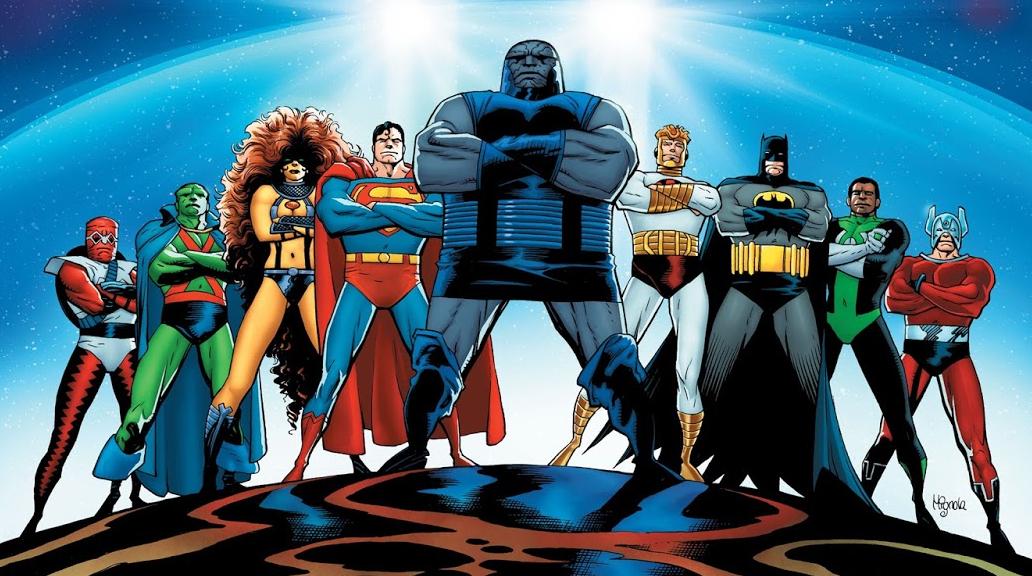
Detail from art for Cosmic Odyssey. Image: Mike Mignola (DC Comics)
It’s cool-looking stuff, but I have no idea how you would or should translate that stuff. Granted, I didn’t watch The Inhumans TV show, but with that Kirby stuff, you need a real big budget to do it big enough.
I haven’t been a fan of most of the DC stuff either. Part of it is that they aren’t my characters and they seem sillier to me than most of the Marvel characters.
So, how do you do the Kirby stuff? I don’t know. It’s… so huge. I think some things just work better as comics than they do as movies.
I know, these days, everyone thinks everything needs to be a movie. Some things just work better as comics. The trick is always going to be getting somebody to translate that stuff who understands what works about the original. Clearly on the Fantastic Four stuff, they never had anybody who really understood what was good about the Fantastic Four.
In the early Marvel movies – like the first Iron Man, the first Captain America – they changed stuff. They moved Iron Man from Vietnam up to present day but they did such a great job of keeping everything that worked about the origin of Iron Man.
I’ve lost interest in most of this stuff now, because it’s so crowded with characters and they’re into storylines that are long past when I was interested in these superhero comics. For the most part, I’ve got that superhero fatigue that I think other people are starting to have. There’s just too much of it. It’s too crowded.
So, you know, I’m looking forward to seeing some quiet, standalone stuff. I have nothing against superhero movies. I thought Wonder Woman was fantastic, and I liked Ant-Man. But when you get into these gigantic epics, and the whole thing turns into, “this is just the middle part of the giant story…” yeah, it doesn’t really work for me any more.
The first collection, Hellboy Omnibus Volume 1: Seed of Destruction, is out now from Dark Horse.
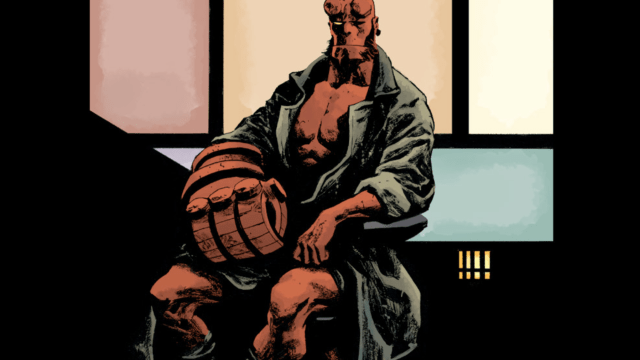
Comments